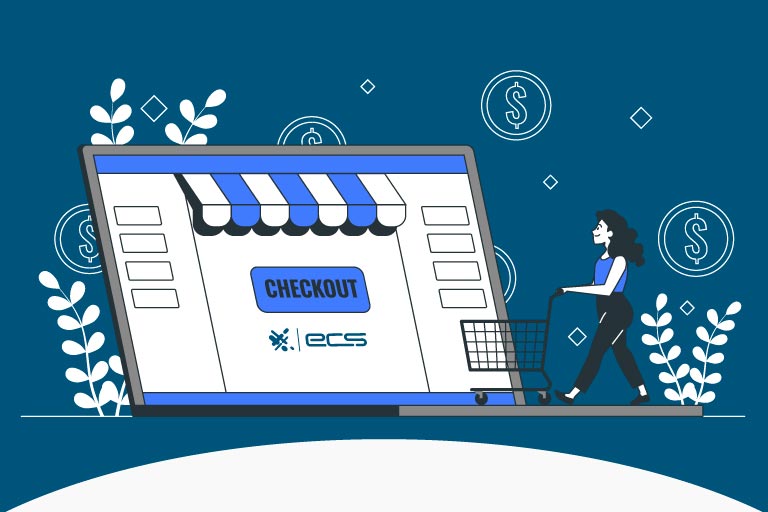Setting up an eCommerce business is one of the best ways to expand your product’s reach and market share. Selling online allows you to reach customers nationwide. Or even worldwide but, to collect payment, first you need to open a merchant account for eCommerce.
There are also far more advertising opportunities and options available when running an online business. Luckily, many of those options can be cheaper than traditional advertising. But starting an eCommerce store has its own set of hurdles. One of those is setting up a merchant account so you can process payments.
In this article, we’ll go over the key steps needed to set up a merchant account and tie in how to use it with your eCommerce website so you can accept credit and debit cards online.
What is a Merchant Account?
A merchant account gives you access to a payment gateway and allows businesses to process electronic payments via online stores or in person. The payment gateway verifies cards such as Visa/Mastercard with the issuers and transfers the funds to your merchant account.
A merchant account is different from a business account. Although both will be necessary to process credit card payments online, a business account refers to a traditional bank account where a business holds its cash. A merchant account is a separate service just for handling electronic payments.
You apply for a merchant account through a payment processor, such as ECS Payment.
Steps To Obtain Your Merchant Account For eCommerce
If you don’t have a merchant account, there are a few key steps you’ll need to follow to apply and obtain one. These steps need to be taken in order as certain documents are generally required to move along in the process.
Although this may sound a bit difficult, it’s actually an easy process once you understand the steps. If you’ve already completed any of these steps, you can skip those and move on to the next step.
1. Register Your Business
Your first step will be to register your business as a legal entity. This means deciding whether your business will be a sole proprietorship, a partnership, or one of several types of corporations like an LLC.
Many web-based businesses choose to register as LLCs. It’s relatively inexpensive and it provides certain tax advantages as well as legal liability protection for your personal assets.
2. Open A Business Bank Account
You will need a bank account registered in your business name in order to secure most merchant accounts. This will also be the account where the payments you receive through your website will be deposited after being withdrawn from your merchant account.
Once you’ve registered your business as outlined in step one, securing a business bank account is easy. If you already have a relationship with a bank, you can simply open one at that location.
Otherwise, you can shop around and compare different banks to see which offerings fit your needs the best. Virtually any business bank account will work. The difference will come down to fees or minimum balances and which options work for you.
Many banks even allow you to apply online and the account is then set up in 24 hours. So obtaining a business account is a fast process and one that you can easily complete in an afternoon.
3. Determine What Category Of Products You Are Selling
You should already know what your business will be selling. But it’s important to know how the different eCommerce merchant services and processors view that product or category.
Certain payment processors have restrictions on what can be sold or how customers can be billed. This can be due to certain items the credit card companies deem as “high-risk”. Certain health products or supplements can fall into this category, as do certain recurring subscriptions.
This is why it’s important to deal with an experienced payment processor such as ECS Payments. They help merchants navigate this area of processing and have options for all categories of products, including high-risk ones.
4. Choose Your Payment Processor
You now have all the information you need to seek out payment processors and apply for a merchant account. There are a lot of choices but you want to choose a processor that fits your needs and business the best.
This means everything from fees to support can be important considerations. Some processors will also have different waiting times until you can access new funds. This can be anywhere from instant to several business days. So depending on your situation, this will be an important consideration as well.
You’ll also want options for different payment gateways such as Authorize.net or NMI. These two payment gateway providers work with your payment processor to transfer customer credit card data and move funds.
It’s important that the processor and gateway provider you choose are compatible with your eCommerce platform or shopping cart software.
5. Apply For A Merchant Account
Once you’ve chosen a payment processor that works best for your situation, you simply apply with all your information from the previous steps.
Processors such as ECS payments can work with you as an individual and make sure you have the best chance of getting approved on the best terms.
Many other processors simply have an automated system where applicants are either accepted or rejected based on the application. ECS can work with customers that may have complex needs or need special consideration, such as poor credit scores.

6. Receive Approval And Start Accepting Payments
Once your application is approved, you are ready to start processing card transactions and accepting payments.
Your processor will give you documentation stating the various policies regarding, transactions, refunds, chargebacks, and other aspects when it comes to working with electronic payment processing.
Make sure to familiarize yourself with this information so you can get your site up and running fast without any unneeded complications.
This includes making sure your website has a valid SSL certificate and all customer information is handled in compliance with PCI guidelines set forth by the card issuers.
Can I Use My Own Merchant Account With Platforms Like Shopify?
The short answer is yes. Although Shopify has its own payment gateway which is Stripe, you can use your own merchant account if you wish.
In some cases, you may need to use your own merchant account as Shopify and other platforms have rules regarding what can be sold on their platform and through their payment gateways. Many types of supplements, health products, digital goods, and other services are not allowed by their payment processor.
Another thing to consider is that when using payment processors like Stripe, you have less control over various billing functions like returns or other processes. For this reason and many others, it’s recommended you secure your own payment processor and merchant account so that you have the most control over your payments and business operations.
Issues With PayPal, Stripe, and Shopify eCommerce Merchant Accounts
PayPal, Stripe, and Shopify services accept payments online and integrate with various eCommerce platforms. The problem is they don’t offer you your own merchant account. Instead, they are aggregators, which means you process through their merchant account.
As a result, you have far less control over your money. Additionally, you will likely pay much higher fees. For example, many of these services use a flat rate fee structure regardless of whether a customer uses a credit card or debit card.
You are paying a higher fee than you would if you had your own merchant account and this one or two-percent difference adds up over time.
Additionally, when using an aggregator, you are bound by their rules which often means no high-risk processing. Or no processing for certain digital goods or services in many cases.
Moreover, customer service can be troublesome. If there is a problem with your account or if fraud is detected that isn’t your fault, they will often deactivate your account and you have little recourse to resolve the issue.
With your own merchant account, you can work with your payment processor to resolve the issue with minimal impact on your business operations and ability to collect payments.
Integrating Your Merchant Account With Your eCommerce Site
To run an eCommerce store, you’ll of course need a website of some kind for customers to browse your products or services and make a purchase.
It’s recommended you host and run your own site instead of using one of the platforms like Shopify. The main reason is the freedom you have when running and hosting your own site. You are not bound by the rules or whims of the platform. And in business, you need the freedom to run things the way you see fit to bring you the most success.
Once you’ve decided on your website and have it running, there are some things you will want to know to make integrating your merchant account with your website much easier. Below are some key terms and definitions and how they relate to integrating a merchant account into your eCommerce site.
E-Commerce Shopping Carts
As a new eCommerce small business it’s important to understand the difference between the shopping cart software with the payment system.
The shopping cart on your site is software that holds and calculates your customer’s orders before purchasing. So by itself, it doesn’t process any payments.
However, your payment gateway will be integrated into the shopping cart. So when customers do make a purchase, they will be brought to the secure page where they can enter their card information and other details.
For example, many eCommerce stores use WooCommerce and WordPress which are then hosted on their own server.
WooCommerce has a shopping cart built-in. So that part is already set up for you as it will be for most shopping platforms. However, there are optional shopping carts you can use that have various functions that may match your products or service better.

Payment Gateway
Your payment gateway is integrated into your website and shopping cart. It sends transaction information to the issuer to accept or decline. This integration involves entering your gateway information and credentials into the associated shopping cart software or WordPress plugin.
Going back to the WooCommerce example, you can use a payment gateway plugin of your choice, either paid or free. Once installed, you can enter your gateway or merchant account credentials into the plugin, and the two services are now connected.
At that point, you would run a few test transactions with various payment methods to make sure everything is working properly.
SSL And PCI Compliance
Any site collecting payment or billing information will need to be SSL-compliant and-PCI compliant.
To be SSL compliant, the website will need to have a valid SSL certificate or a Secure Socket Layer certificate. Your hosting company will usually offer this service either included with your web hosting package or for an additional annual fee.
Your host will then install this certificate for you using the domain you choose.
An SSL certificate ensures encrypted communications between your site and customers and your site and the payment processor.
PCI or PCI DSS compliance refers to the Payment Card Industry Data Security Standard.
These are actionable guidelines for securely handling customer data and billing information. Many of these guidelines are simply best practices that most reputable websites and hosts will already be following.
An experienced payment processor like ECS Payments has in-house, dedicated support representatives that can help you if you have any questions regarding PCI compliance issues.

More Information About Merchant Accounts And eCommerce
ECS Payments is a leading name in eCommerce and payment processing. Our staff can work with a variety of products, including high-risk, to make sure your business can accept the most payments and maximize revenue.
To contact sales, click HERE. And to learn more about ECS Merchant Accounts visit Merchant.
